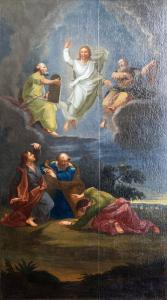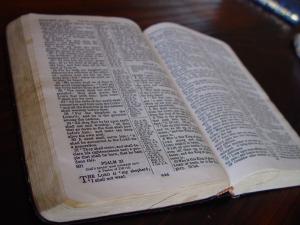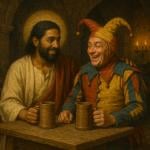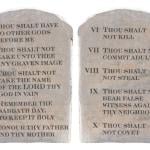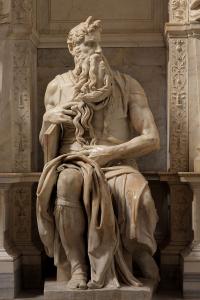 On every Transfiguration Sunday, the collectors of the lectionary choose this odd little passage from Exodus as a pairing with the far more famous transfiguration tales that adorn the Synoptic Gospels. In the Gospels, Jesus is said to be “transfigured” on a mountain top, that is somehow changed from a simple teacher into some manner of divine being, radiating a blinding whiteness to two of his disciples and conversing with two ancient worthies from the past, Moses and Elijah. Those texts bristle with exegetical challenges that I will gladly leave to my New Testament colleagues. The Exodus story is odd enough as any careful reading of it amply demonstrates.
On every Transfiguration Sunday, the collectors of the lectionary choose this odd little passage from Exodus as a pairing with the far more famous transfiguration tales that adorn the Synoptic Gospels. In the Gospels, Jesus is said to be “transfigured” on a mountain top, that is somehow changed from a simple teacher into some manner of divine being, radiating a blinding whiteness to two of his disciples and conversing with two ancient worthies from the past, Moses and Elijah. Those texts bristle with exegetical challenges that I will gladly leave to my New Testament colleagues. The Exodus story is odd enough as any careful reading of it amply demonstrates.
The translation of the passage is difficult at several key spots, and how one reads those places will largely determine just how one adjudicates the meaning of the text. Ex.34:29 is odd enough. Here is something like a literal rendering: “And so it happened, Moses was coming down from the mountain of Sinai, with the two tables of treaty (or “testimony”) in the hand of Moses; and while he descended from the mountain, Moses did not know that the skin of his face was shining (or “horned”) while he spoke with God.” Already I have made certain decisions that will substantially affect my hearing of the text. I have read “while he spoke with God,” but the NRSV reads “because he had been talking to God.” My translation assumes that the shining (or horned) face of Moses occurred during his conversation with YHWH on Sinai while the NRSV seems to imply that the shining (or horned) face was a later result of the Moses-God conversation. That may be a subtle distinction, but the difference may prove important later in the story. In addition, there really is scant evidence to support a translation of “shining” of that word that nearly everywhere means “horn”. It might well be then that the image in mind here is precisely that after Moses’ chat with God, his head was now horned, like some strange animal-like figure.
“When Aaron and all the children of Israel saw Moses, and noted that the skin of his face was shining (or “was horned”), they were afraid to approach him” (Ex.34:30). In other words, his peculiar shining/horned face was so odd that he looked spooky to Aaron and the Israelites, so spooky that they were terrified. “Moses called them, and Aaron and all the congregation of Israel returned to him; and Moses spoke to them” (Ex.34:31). Apparently, Moses’ familiar voice convinced those awaiting his return from Sinai that it was in fact their leader, and that his shining/horned face has not obliterated the person they knew; it is still Moses.
This may be the time to explain once again why Michelangelo’s famous statue of Moses has two rather prominent horns, one on each side of Moses’ head. The Hebrew word that has more recently been taken to mean something like “shining,” has the more common meaning of “horn,” like the horn of an ox. The word may also mean “power” in the more metaphorical sense. When the Latin Vulgate translation was made by Jerome in the 4th century CE, the version that Michelangelo surely knew, he read the word in its common meaning and translated the word as cornu, Latin for horn. It should also be noted that the Hebrew qeren is quite close in sound to nearly all words for “horn” in other Semitic languages, as well as in Greek (keras) and Latin, as we have just seen. Thus, it could be concluded that Moses’ depiction by Michelangelo perhaps is not so far from that imagined by the authors of Ex.34. They may have thought that Moses, after his talk with YHHW, appeared to Israel as some sort of horned demon. Little wonder that they were scared!
“After that, all the Israelites drew near, and Moses gave in commandment form all that YHWH had spoken to him in Mount Sinai” (Ex.34:32). This rather odd sentence implies that after Israel overcame their terror at the peculiar presence of Moses as either shining or horned, he then told them in a decidedly commanding way everything that YHWH had said to him on the mountain. He did not here “give them the commandments” he is said to be carrying in his hand, but rather he tells them commandingly what God said to him.
“When Moses had finished speaking with them, he put a veil over his face” (Ex.34:33). One can only presume that this veil was to hide his grotesque countenance from the people, who, I assume, had not fully gotten over the way their leader now looks. “But when he went into the presence of YHWH to speak with YHWH, he would take the veil off, until he reappeared; and when he came out (from YHWH’s presence), he told the people what he had been commanded; the Israelites would see Moses’s face, that his skin was shining/horned. So Moses would put the veil back on his face until he went back to speak with God” (Ex.34:34-35).
What in the world does all of that possibly mean? It clearly is a very ancient notion that speaking with the God is transformative; one cannot converse with divinity and come out unscathed. Moses is quite literally transformed after a conversation with YHWH into some kind of horned or glowing beast, such that his own people want nothing to do with him until he convinces them that he is still Moses, the giver of God’s Torah. Yet, when he returns to continue his talk with YHWH, he pulls the veil off his deformed face in order to speak with God once again. It is as if God has made Moses something closer to what God is, something between God and human, something surely more than human though still less than God.
It could be here that this odd text has some intersection with the Transfiguration stories of the Gospels. In those stories Jesus is plainly presented as something more than human, plainly the “beloved son,” as one of the accounts proclaims. Jesus is teacher and leader of the disciples, but after the strange event on the mountain, and after Moses and Elijah have conversed with Jesus, and after their disappearance from the scene, Jesus remains alone and thus unique among the great leaders of the past, greater than the lawgiver Moses and greater than the prophet Elijah. God commands all to “listen to him.” Just like Moses, who mediates between God and the people, so too does Jesus speak the words of God that the people need to hear. As strange as all of these tales are, they bear a certain odd resemblance; Jesus is the new Moses on the mountain, speaking the word of his God, but according to the Gospel writers, he is greater than Moses, who, though transformed, is still Moses, however altered his face, while Jesus, transformed, is nothing less than the son of God. Reading the Exodus story apart from the stories in the Gospels convinces us that Moses is unique in his proximity to YHWH; no one else but he “speaks to YHWH face to face.” That face may be horribly transformed by his meeting with God, but he is thereby enabled to speak to God directly. Might it be that we need a transformation by God in order to be enabled to communicate with God directly and helpfully? That transformation may appear to others to be little less than grotesque, making us quite different from the way we were, but only such a transformation may enable us to come into the courts of God and thereby become at last a child of God, ready and willing to do what we are asked.
(Images from Wikimedia Commons)
